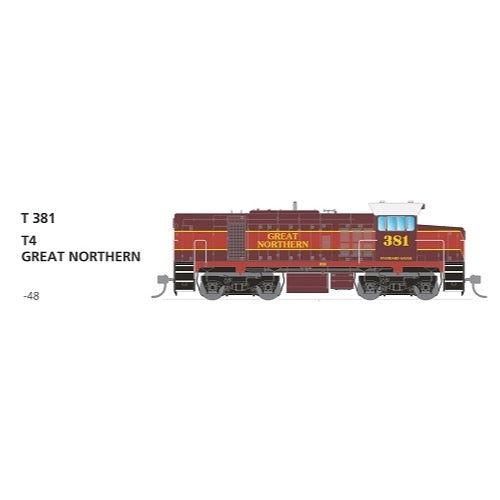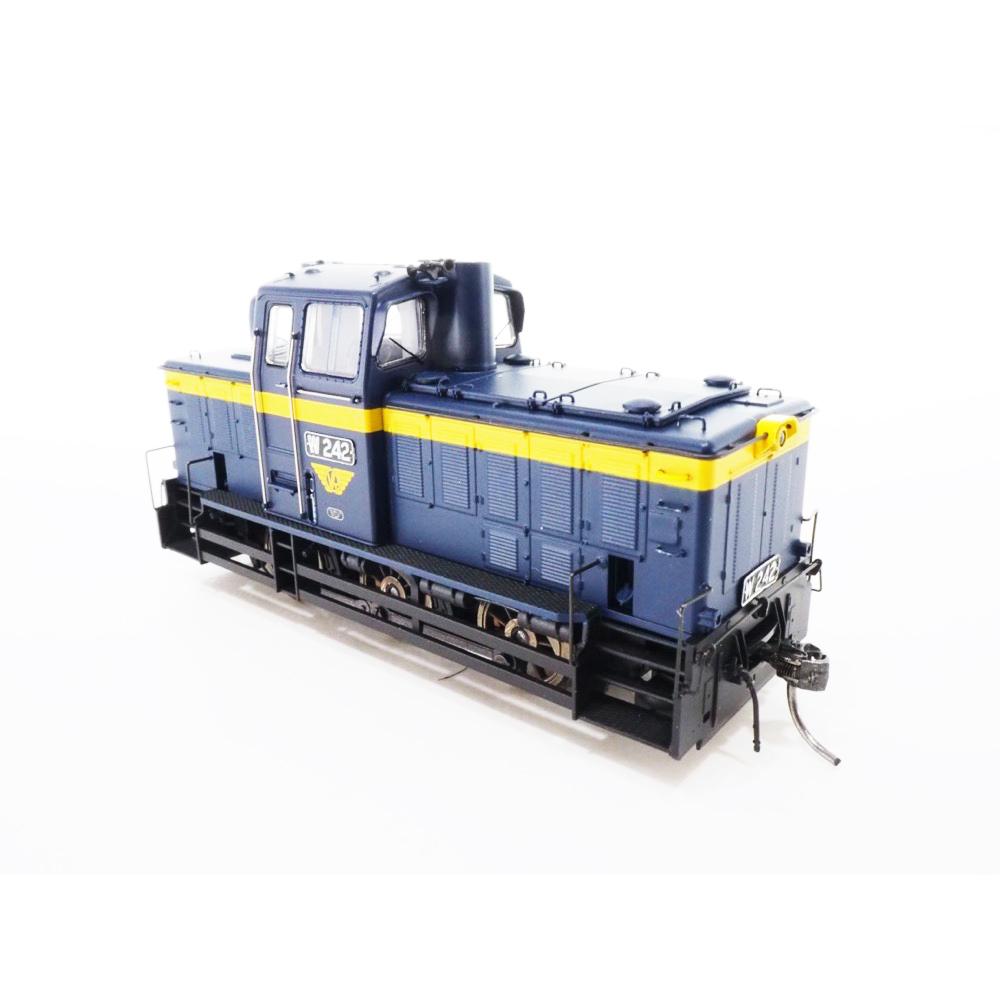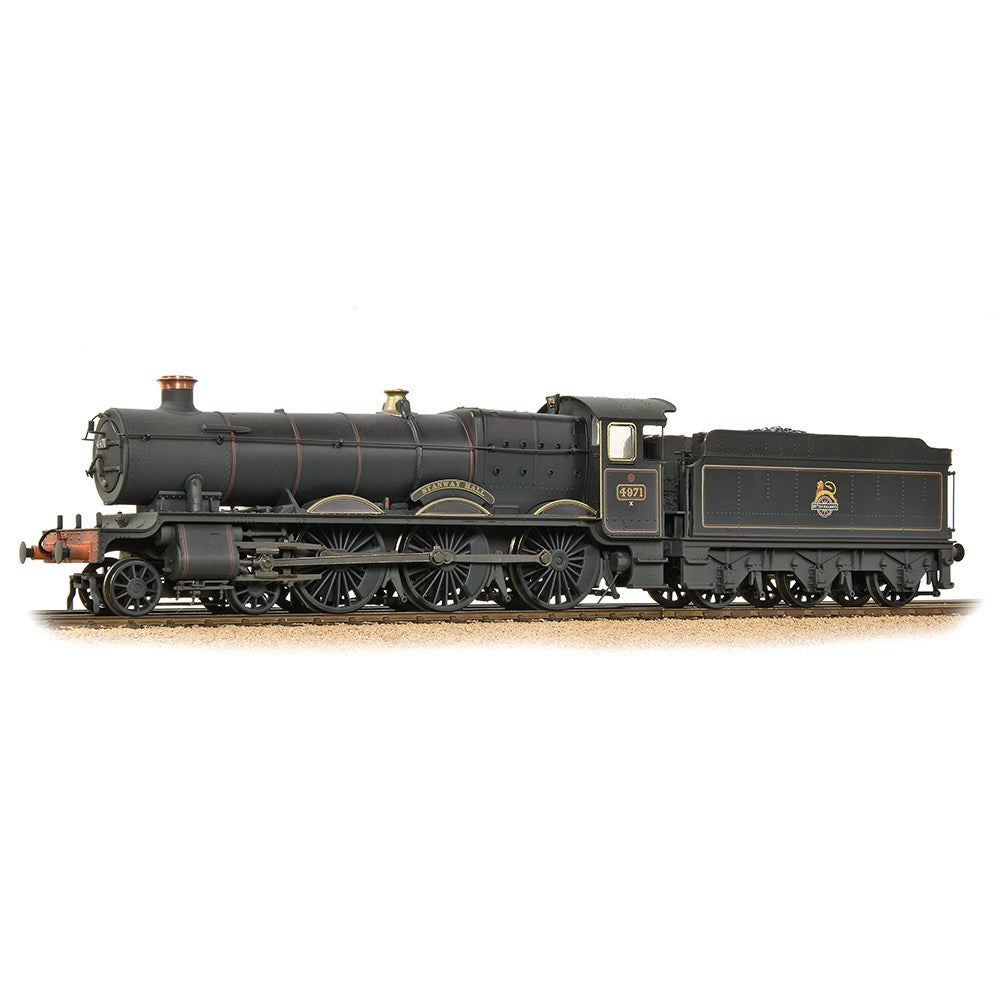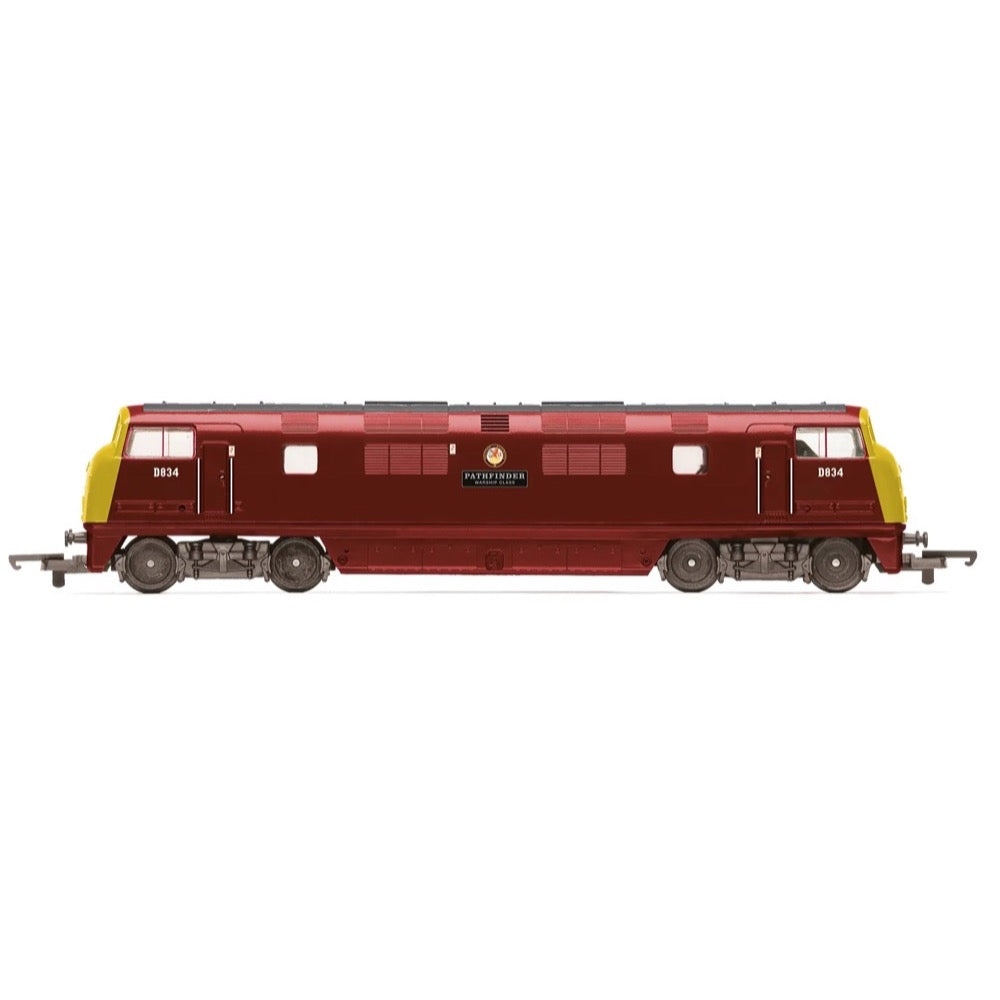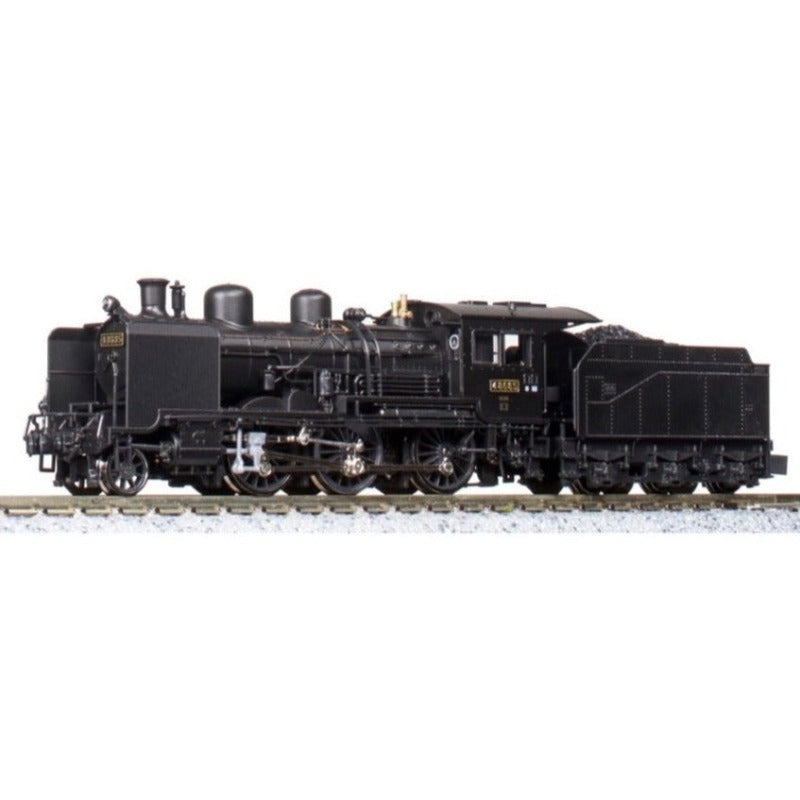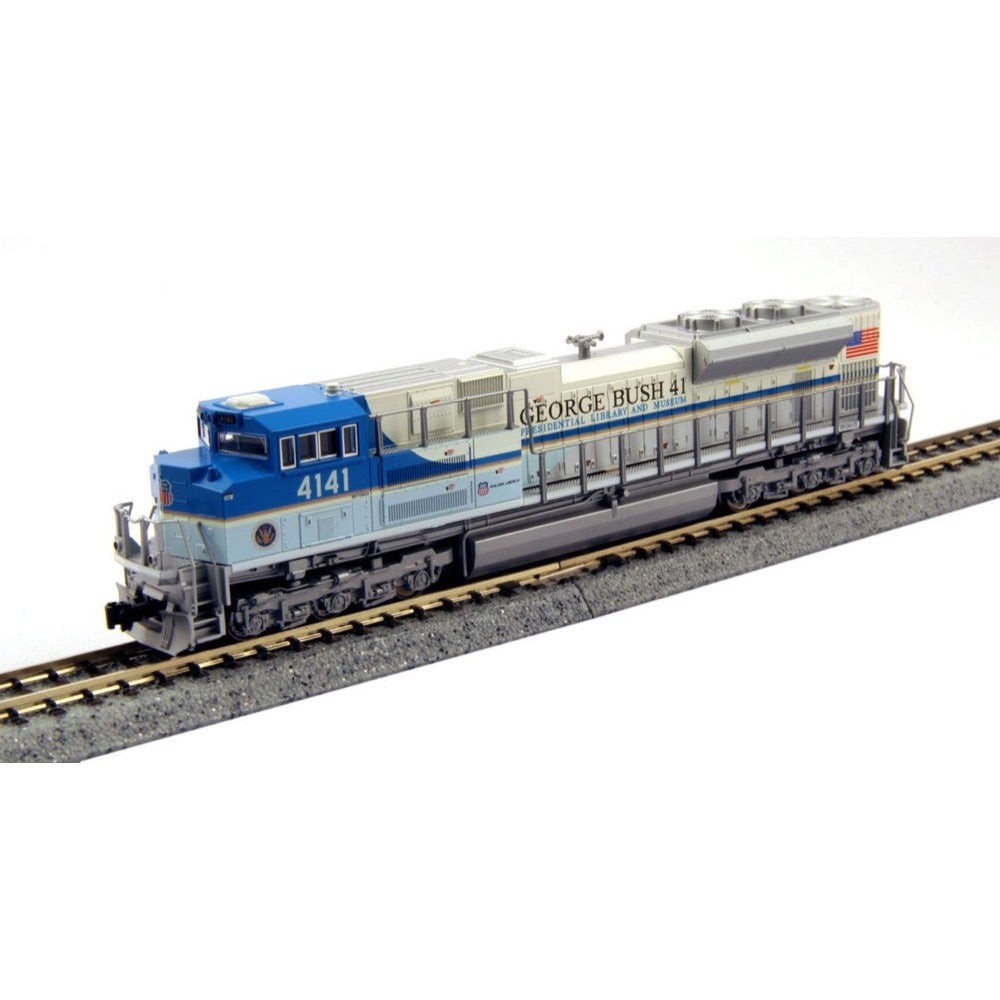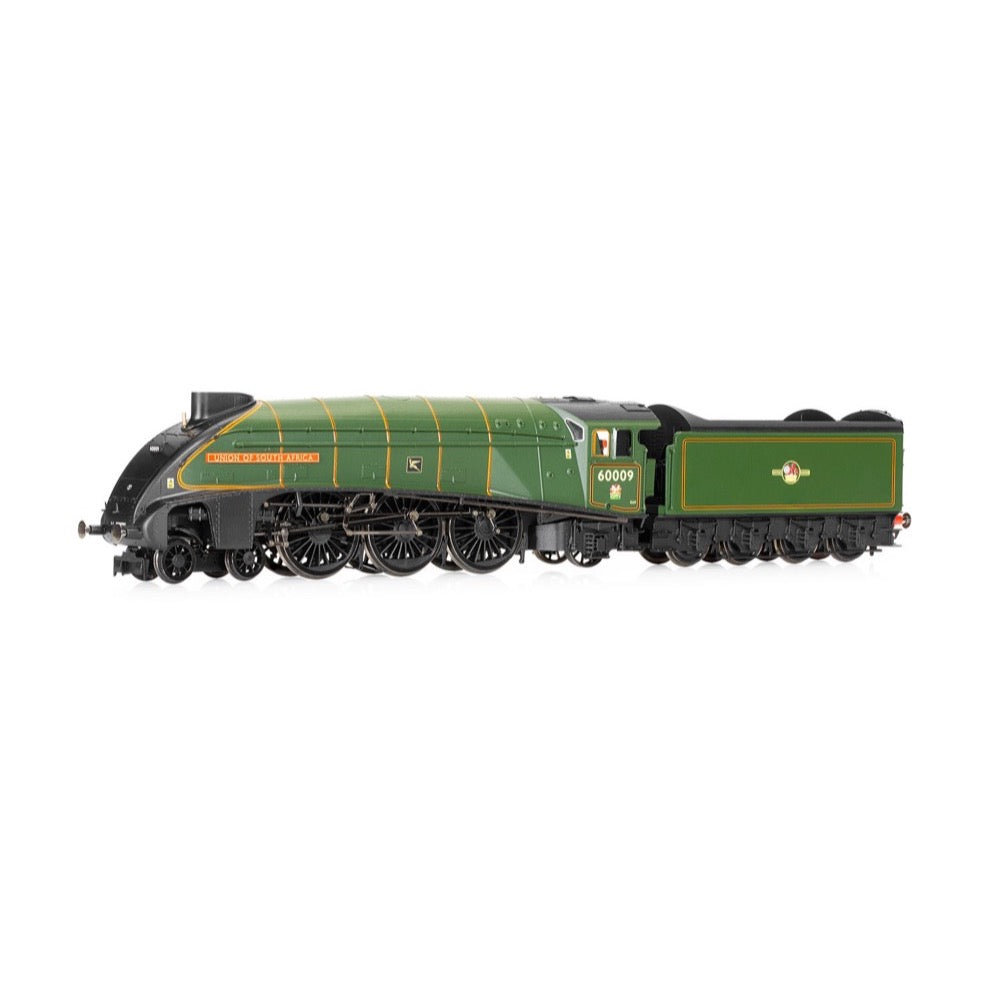
Hornby Dublo R30263 OO BR Class A4 4-6-2 60009 Union of South Africa Great Gathering 10th Anniversary Era 10 Locomotive
The LNER Gresley A4 is one of the most iconic express locomotives in Great Britain, with its streamlined casing a classic symbol of the attitude towards speed and design in the 1930s, which saw increased competition to the railways from road and air travel. The LNER Board knew they had to make travel between the major cities faster, comfortable and more reliable.
Nigel Gresley, the LNER's Chief Mechanical Officer, travelled on the Fliegende Hamburger diesel locomotive in Germany and was impressed by its streamlining. However, he realized it was only efficient at high speeds. Gresley was certain that a modified A3 Pacific, with streamlining, could haul greater loads than other locomotives at the same speed or faster and a series of trials were conducted to confirm the A3's suitability.
With the trials successfully completed, the LNER Board gave Gresley the go-ahead to create the "Silver Jubilee" streamlined trains, the first of the new streamlined A4s. The streamlining of the A4s' steam circuit, higher boiler pressure and extension of the firebox to create a combustion chamber, made them more efficient than the A3. As they consumed less coal and water, especially later on when they were also fitted with a Kylchap double chimney. This improved their free steaming capabilities further.
Their streamlined design not only made them capable of high speeds but created an updraught of smoke, obscuring the driver's vision, a major problem on the new Class A4 engines. The story goes that during wind tunnel testing, after several unsuccessful efforts to get the smoke to lift clear, a thumbprint was inadvertently left on the clay model just behind the chimney. This succeeded in clearing the smoke and was incorporated into the final design.
Union of South Africa was one of five LNER A4 locomotives designated to haul the Coronation train, such locomotives can be identified from the British Empire derived names. The locomotive was introduced as 4488 on the 29th June 1937, with the name Osprey originally allocated to the locomotive but not assigned.
The locomotive would be withdrawn from the BR service in June 1966 and has gone on to be preserved. During preservation, the locomotive would carry its originally assigned Osprey name for political reasons. The tender connected to 60009 Union of South Africa in preservation is that originally connected to LNER 10000, the W1 Hush Hush, one of the only manifestations of the experimental engines remaining.
Hornby Dublo A4 models feature a diecast body, just as their original Hornby Dublo counterparts would have seen. This is coupled with enchanted decoration which when paired with the diecast of the boiler provides a realistic finish to the body. The models contain a 5 pole motor with flywheel and are DCC ready with an 8 pin socket.
Specifications
- Item Length - Without Packaging (cm): 29.1
- Item Height - Without Packaging (cm): 5
- Item Width - Without Packaging (cm): 3.5
- Item Weight - Without Packaging: 0.6
- Item Scale: 1:76 Scale 00 Gauge
- License: Yes
- License line: Produced under licence for SCMG Enterprises Ltd. © SCMGE. Every purchase supports the museum.
- Finish: Painted
- Colour: Green
- Gauge: OO
- DCC Status: DCC Ready 21 pin socket
- Operator: BR
- Designer: Sir Nigel Gresley
- Wheel Configuration: 4-6-2
- Livery: BR Lined Green
- Minimum Curve (mm): Radius 2
- Motor: 5 Pole Skew wound
- Number of Parts: 1
- Class: A4 Class
- Buffer Type: Sprung Metal Buffers
- Coupling Type: NEM Tension Lock
- Hornby Decoder Compatibility Primary: HM7000-8TXS: Bluetooth® & DCC Sound Decoder (21-pin)
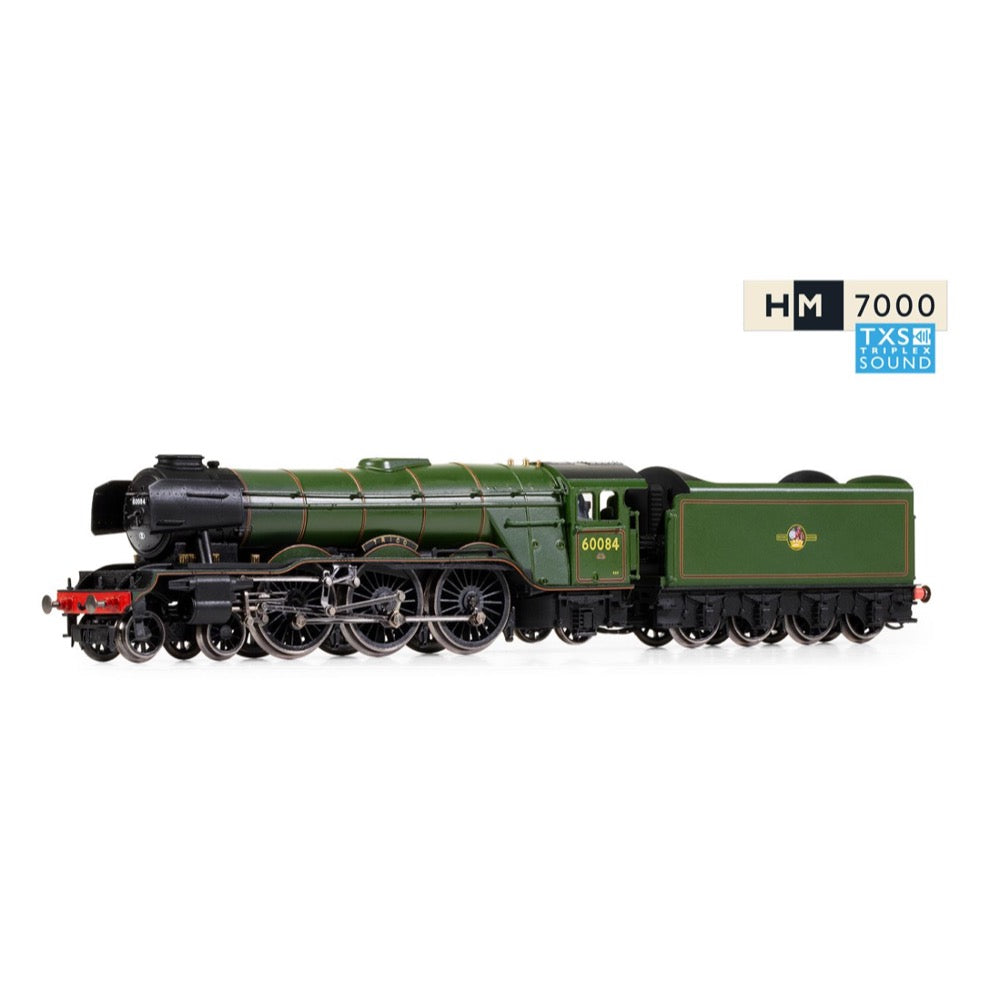
Hornby TT3006M TT BR Class A3 4-6-2 60084 Trigo Digital Locomotive
While the A1 was a fantastic locomotive that served its purpose as intended, it became clear reasonably quickly that some modifications could be made that would greatly improve its performance. These modifications however were too significant to avoid reclassifying the locomotives and as such the A1 Felstead 2743 was the first to be withdrawn from service only a handful of years after it was introduced, emerging from its shed in August 1928 as the first A3 ‘Super Pacific.’
The newly designated A3 locomotives had an improved boiler, larger cylinders and a conversion from right to left hand drive. 27 of the class were built as A3 locomotives from the get go, with all of the in service A1 examples being converted before 1950, the last such example to undergo this transformation was the then BR numbered 60068 Sir Visto.
2595 Trigo would enter LNER service in 1930, being one of the 27 A3 locomotives to never turn a wheel as an A1. The locomotive would go through the same short lived numbering pattern as its classmates carrying the number 84 for a short time before adopting its longer term BR number of 60084 on nationalisation. Along with all but one other member of the class, Trigo was unceremoniously scrapped in November 1964.
Specifications
- Item Length - Without Packaging (cm): 19.1
- Item Height - Without Packaging (cm): 3.7
- Item Width - Without Packaging (cm): 2.5
- Item Weight - Without Packaging: 0.15
- Item Scale: 1:120 Scale
- Finish: Painted
- Colour: Green
- Gauge: TT
- DCC Status: Next 18 Socket (NEM 662)
- Operator: BR
- Designer: Sir Nigel Gresley
- Wheel Configuration: 4-6-2
- Livery: BR Green
- Minimum Curve (mm): Radius 2
- Motor: 3 Pole
- Number of Parts: 1
- Class: Class A3
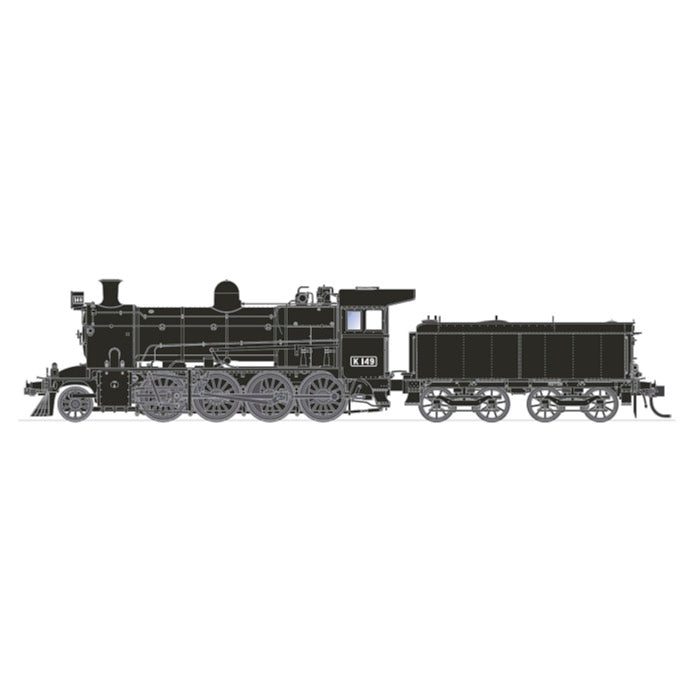
SDS Models HO K149 Victorian Railways Original K Class Locomotive DCC Sound
The Victorian Railways built ten K class engines at Newport Workshops between 1922/23, numbered 100 to 109. They were originally put to work on branchline goods services, however they soon came to work all types of trains.
In 1940 they were renumbered to 140 to 149, later again they were rebuilt with Modified Front End. The models represent the original version and the renumbered version.
Features
- Highly detailed Ready-to-Run HO gauge model
- Precisely tooled body
- Genuine Kadee scale head whisker coupler (Tender)
- Separately applied handrails and detail parts
- All wheel electrical pickup
- LED headlights and marker lights
- All models come standard with an MTC 21 pin motherboard
- Keep Alive Circuit
- Exclusive sound by DCCSound
- 22" Minimum radius recommended

Hornby R30040TTS OO BR Class 47 Co-Co 47583 County of Hertfordshire TTS DCC Sound
Built between 1962 and 1968, the British Rail (BR) Class 47 Co-Co Diesel-Electric locomotive was once the most numerous class of mainline diesel in Britain with 512 examples. 310 locomotives were constructed by Brush in Loughborough, and the remaining 202 at Crewe. The locomotives were used for passenger and freight operations.
In 2020, 24 of the class remain operational on the national network with more in storage and an additional 31 preserved. Built in October 1964 as D1767 the locomotive was initially assigned to the Tinsley depot. Under TOPS the locomotive was initially numbered 47172. The locomotive received the name 'County of Hertfordshire' in 1979 before being reclassified a class 47/4 and renumbered 47583 in November 1980.
In 1981 the livery of the locomotive was updated to mark the wedding of HRH Prince Charles and Lady Diana Spencer featuring a large BR arrow uniquely lined in Red and Blue.
Specifications
- Item Length - Without Packaging (cm): 25.1
- Item Height - Without Packaging (cm): 5
- Item Width - Without Packaging (cm): 3.5
- Item Weight - Without Packaging: 0.23
- Item Scale: 1:76 Scale 00 Gauge
- License: No
- Finish: Painted
- Colour: Blue
- Gauge: OO
- DCC Status: DCC Ready 8 pin socket
- Operator: BR Large Arrow
- Designer: Brush
- Livery: BR Corporate Blue
- Minimum Curve (mm): Radius 2
- Motor: 5 Pole Skew wound
- Number of Parts: 1
- Class: Class 47
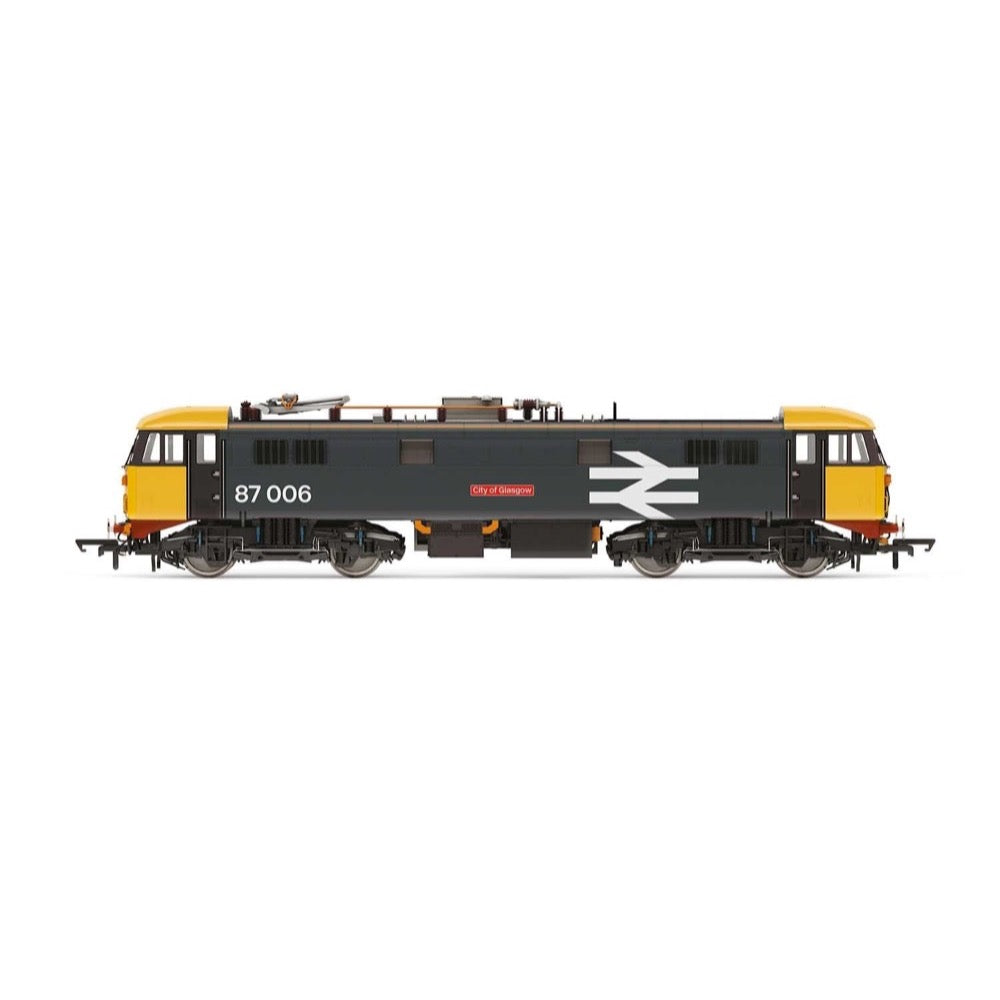
Hornby R30030 OO BR Class 87 Bo-Bo 87006 City of Glasgow
The Class 87 locomotive design resulted from a requirement for a more powerful mixed traffic electrical locomotive by British Rail, needed to cope with the route gradients of the West Coast Main Line between Weaver Junction and Glasgow. Electrification had been newly authorised over this section in 1970 and was scheduled for completion by May 1974, leaving little time to design a completely new locomotive from scratch and so British Rail decided to base the new class on the existing Class 86 locomotives. The British Railways Board placed an order for thirty four locomotives, later to be increased to thirty six, with British Rail Engineering Ltd at Crewe, GEC Traction providing the electrical equipment.
Designed from the outset to work in pairs, as well as in parallel with the Class 86 fleet, the Class 87 was broadly similar to the Class 86 in terms of layout and styling, but mechanically it was a very different. Immediately identifiable by its new twin windscreen cab, multiple-unit control cables and a redesigned BP9 bogie with Flexicoil suspension, the new locomotives were assembled during 1973-74 and were geared for 110mph running on the WCML, being able to haul 450 ton passenger trains, or 750 ton freight trains single handed.
With a power rating of 5000hp, they were to be the most powerful locomotives to run under British Rail until the late 1980s. The first locomotive, 87001, entered traffic in June 1973, the remainder of the fleet being deployed in the general West Coast pool as they entered service, operating Euston to Preston services as the WCML's electrification spread north.
On April 22, 1974 the new West Coast 'Electric Scot' service was introduced, marking a major launch for the class and journey times from London-Glasgow were cut to just five hours. When British Railways reversed its locomotive naming policy in 1977, the class were given the generic title of 'Royal Scot' and named from a selection of famous steam hauled predecessors. Sectorisation of the railways in the late 1980s/early 1990s meant rail freight operations were wound down and the fleet were engaged solely on passenger services. Following complete privatisation in the mid-1990s, Porterbrook leasing took over ownership of the fleet, but the introduction of the Pendolino trains led to the Class 87s being withdrawn from the core InterCity routes and complete withdrawal began in 2003, with 87016 being the first to be dismantled in November 2004.
The last mainstream locomotive hauled service took place on June 10, 2005 and Porterbrook began to look at how best to employ the locomotives, spells with DRS, Cotswold Rail and First GBRf ensuing. The fleet, not being fitted with On Train Monitoring and Recording (OTMR) could not operate beyond January 1, 2008 and were finally withdrawn from service, some going to Bulgaria between 2008 and 2012. No. 87006 entered traffic in November 1973 and was named 'City of Glasgow' between December 1977 and 1987. After this it was briefly named 'Glasgow Garden Festival' until 1989 at which point it returned to being called 'City of Glasgow' until 1997.
In 1984, 87006 and 87012 were selected to trial new liveries in advance of an improved 110mph service on the WCML. 87006 received a version of the large-logo livery, but with dark grey as the base colour rather than Rail Blue, while 87012 received a version of the APT-P livery, which became known as InterCity Executive livery. In 2009 87006 was one of the class to be exported to work for the Bulgarian Railway Company.
Specifications
- Item Length - Without Packaging (cm): 24.3
- Item Height - Without Packaging (cm): 5
- Item Width - Without Packaging (cm): 3.5
- Item Weight - Without Packaging: 0.57
- Item Scale: 1:76 Scale 00 Gauge
- License: No
- Finish: Painted
- Colour: Grey
- Gauge: OO
- DCC Status: DCC Ready 21 pin socket
- Operator: BR
- Designer:BREL
- Livery: BR Grey
- Minimum Curve (mm): Radius 2
- Motor: 5 Pole Skew wound
- Number of Parts: 1
- Motor: 5 pole skew wound
- Class: Class 87

On Track Models HO 8204 Pacific National 82 Class Locomotive
Sample image supplied for illustration purposes only. Actual model will display authentic numbering and will vary.
With the introduction of these locomotives a wide spread reduction of the NSW locomotive fleet had begun. The first casualties were the veteran fleet of 44 class Alco’s, then the 45 and 442 classes along with the Mark I 48 class. Further reductions to the locomotive occurred with the withdrawals of the 422 and 49 classes.
This overall fleet reduction reduced the average age of Freight Rail’s locomotive fleet from over twenty five year old to approximately ten.
These locomotives have travelled all over NSW and have ventured into Queensland and Victoria on intermodal freight services, and in South Australia on the Leigh Creek coal service. They are currently seen on both coal and wheat services all over the state, through Sydney, and the occasional local trip train around the Sydney metropolitan area.
On Track Models is pleased bring you this highly desired locomotive as a highly detailed model in HO Scale.
Improvements:
- ESU designed PCB with two sugar cube speakers
- Independent working headlights, white and red marker lights (DCC only)
- See through Dynamic blower housing with box
- Improved one-piece MU cables
- Improved air hoses
- Improved axles bushes for better electrical pick up
- Factory Painted & Decorated in new PN livery
Standard Features:
- Ready-to-Run
- Scale AMRA Profile Metal Wheels
- All wheel drive - All wheel pick up
- 18"" Recommended minimum radius
- Highly detailed bogies with separately applied parts
- Easy access to the DCC 21 pin plug
- Easy body removal
- Quality 5 pole skew wound motor
- Die cast metal chassis with recesses for twin speakers
- Twin brass flywheels
- Etched metal detail parts
- Separately applied metal parts
- Genuine Kadee Metal Couplers
- Detailed cab interrior
- Operational headlights, foglights, & marker lights
- Compatible with Code 70, 83, & 100 Rail
- Accurate Paint Schemes & Printing
- Factory Painted & Decorated


